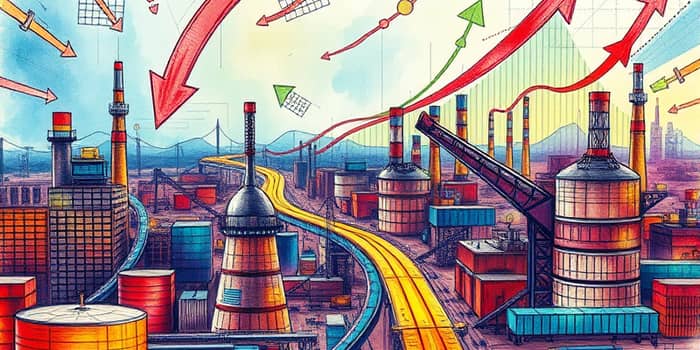
In recent months, global industrial production data has sent ripples through economic forecasts, compelling analysts and policymakers to reassess expectations. The interplay of regional performance, sectoral disparities, and external shocks has created a dynamic environment where numbers not only reflect past performance but also reshape future outlooks. As growth accelerates in some regions while others falter, the narrative of industrial output becomes a critical gauge for forecasting global economic health.
The rapid shifts in industrial production underscore the evolving nature of global supply chains and the delicate balance between demand surges and capacity constraints. Companies that once relied on predictable patterns now grapple with volatility in raw material prices and logistics bottlenecks. Amid these challenges, data emerges as a vital tool for anticipating trends and recalibrating strategies in real time.
In February 2025, world industrial production climbed by 0.9% month-on-month, a sharp turnaround from January’s 0.1% decline. Year-on-year growth hit 3.7%, up from 3.0% the previous month. Emerging Market and Developing Economies (EMDEs) led this resurgence with a 1.4% increase, outpacing Advanced Economies’ 0.8%. Asia, in particular, demonstrated robust momentum, reinforcing its role as the locomotive of global manufacturing.
However, regional disparities remain stark. Emerging and Developing Europe saw a modest contraction of 0.2%, while Sub-Saharan Africa declined by 1.5%. Country-level data further illustrates this divergence: the United States saw a 0.2% drop in May 2025, and the United Kingdom faced a 0.3% decline in April. In contrast, Vietnam’s output surged by 9.4% in May, and Uruguay posted a 7.2% gain in April.
Analysts emphasize that such figures are more than mere statistics; they narrate the resilience or fragility of regional economies. For emerging markets, stronger growth has been buoyed by robust domestic demand and government-led infrastructure spending, whereas several advanced economies contend with waning export orders and elevated borrowing costs.
Across the manufacturing sector, significant investment in digital technologies is reshaping factory floors and product lifecycles. Companies allocated nearly 30% of their operating budgets to technology in 2024, up from 23% in 2023. Cloud computing, generative AI, and 5G infrastructure stand out as the top three areas promising the highest returns on investment. These advancements facilitate real-time monitoring, predictive maintenance, and agile supply chain adjustments.
Real-world examples abound. A leading automotive supplier reported a 15% reduction in machine downtime after deploying AI-driven predictive maintenance, while a food and beverage manufacturer accelerated its production cycle by integrating cloud-based monitoring. These case studies highlight the tangible benefits of marrying operational expertise with digital platforms.
Faced with rising costs and ongoing skill shortages, manufacturers are leveraging digital tools to maintain competitiveness. By integrating simulation and AI solutions, companies can anticipate disruptions and optimize workflows. This trend underscores a broader shift toward software-driven manufacturing and connectivity, where data flow is as vital as raw materials.
Trade policy has emerged as a pivotal external factor. In the lead-up to new tariffs on steel, aluminum, and other sectors, output experienced a surge in manufacturing output ahead of implementation. March 2025 U.S. manufacturing jumped by 0.9% as firms stockpiled inventory to avoid higher duties. Yet, economists warn that once tariffs take effect, elevated prices and dampened demand will likely curb production and investment.
These developments have raised the heightened risk of global recession in some forecasts. Key indicators such as the ISM new orders index have dipped into contraction territory, registering 45.2 in March where readings below 50 signal a downturn. Meanwhile, Europe is crafting a new industrial strategy centered on innovation and decarbonization goals and reducing import dependencies to enhance resilience amid fierce global competition.
Adding to the complexity, geopolitical tensions — such as U.S.-China trade frictions and Middle East energy uncertainties — further cloud the outlook. Freight costs have surged sporadically, and energy price volatility has forced some factories to curtail output temporarily. These variables heighten the challenge for forecasters striving to deliver accurate projections months in advance.
Within manufacturing, challenges vary by sector. Heavy manufacturing continues to struggle with weak demand, particularly in metals and mining, prompting workforce reductions. The automobile and auto parts industry has endured a prolonged contraction, though Europe saw a brief stabilization after 21 months of decline. Consumer goods, including food and beverages, slipped into contraction in March for the first time in eighteen months.
Regional governments are stepping in with targeted measures. In Europe, subsidies for green manufacturing aim to accelerate decarbonization. In the United States, proposals for tax credits on domestic production and workforce development grants are gaining traction. Meanwhile, several Asian economies are reinforcing special economic zones to attract investment and diversify production bases.
As firms and governments digest these shifting data patterns, a range of strategic responses is emerging. Addressing the persistent skills gap in industry will require coordinated efforts in vocational training, academic partnerships, and incentives for technical education. Companies are also exploring strategic diversification and resilience-building by establishing multi-region supply chains and investing in automation to mitigate future shocks.
Scenario planning is becoming a standard part of corporate strategy sessions, enabling firms to model diverse outcomes ranging from accelerated growth to prolonged downturns. Embracing circular economy principles, organizations are also exploring resource-efficient processes and product lifecycle management to reduce waste and enhance sustainability.
Policymakers can support these initiatives by fostering an environment conducive to innovation, reducing regulatory burdens, and encouraging cross-border collaboration. Falling interest rates may further accelerate capital deployment into high-ROI areas, bolstering the broader industrial ecosystem.
In this era of rapid change, accelerated digital transformation in factories and proactive risk management will define the leaders of tomorrow’s industrial landscape. By leveraging insights from production data and embracing forward-looking strategies, stakeholders can navigate uncertainties and steer global manufacturing toward a more resilient and sustainable future.
References













